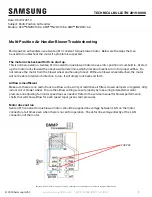
System Start-up
RT-SVX35H-EN
65
closing "Stage 1" (K10 on SCM or K11 on MCM). After the
first functional stage has started, the compressor module
monitors the saturated refrigerant temperature and closes
the condenser fan output contact "1A", when the saturated
refrigerant temperature rises above the "lower limit"
setpoint.
Units with
Traq™Sensor
The fresh air enters the unit through the
Traq™ Sensor
assembly and is measured by velocity pressure flow rings.
The velocity pressure flow rings are connected to a
pressure transducer/solenoid assembly. The solenoid is
used for calibration purposes to compensate for
temperature swings that could affect the transducer. The
Ventilation Control Module (VCM) utilizes the velocity
pressure input, the RTM outdoor air temperature input,
and the minimum outside air cfm setpoint to modify the
volume (cfm) of fresh air entering the unit as the measured
airflow deviates from setpoint.
When the optional temperature sensor is installed and the
Preheat function is enabled, the sensor will monitor the
combined (averaged) fresh air and return air
temperatures. As this mixed air temperature falls below
the Preheat Actuate Temperature Setpoint, the VCM will
activate the preheat binary output used to control a field
installed heater. The output will be deactivated when the
temperature rises 5° above the
Preheat Actuate
Temperature Setpoint.
When the optional CO
2
sensor is installed and the CO
2
Reset is enabled, as the CO
2
concentration increases
above the CO
2
Reset Start Value, the VCM will modify the
minimum outside air cfm setpoint to increase the amount
of fresh air entering the unit. The setpoint will be adjusted
upward until the CO
2
Maximum Reset Value is reached.
The maximum effective (reset) setpoint value for fresh air
entering the unit is limited to the systems operating cfm.
As the CO
2
concentration decreases, the effective (reset)
setpoint value is adjusted downward toward the minimum
outside air cfm setpoint.
Units equipped with 100% modulating
exhaust
The exhaust dampers are controlled through an Exhaust/
Comparative Enthalpy Module (ECEM). The ECEM
receives input form a space transducer and modulates the
exhaust dampers to maintain the space pressure to within
the specified setpoint controlband.
Gas Heating Sequence of Operation
Standard Two Stage Gas Furnace
The control systems for the rooftop units are wired to
ensure that the heating and cooling cannot occur
simultaneously. A typical electrical schematic for the
Fenwal and Honeywell ignition control system is
illustrated in
. Refer to
the wiring diagram while reviewing the following
sequence of operation.
Honeywell Ignition System
When a heating requirement exists, the Rooftop Module
(RTM) starts the supply fan and sends a request for heat to
the Heat Module. The Heat Module closes K1 contacts and
starts the combustion blower motor (4B11). The
combustion blower motor starts on low speed through the
normally closed combustion blower relay (4K33) contacts.
The supply airflow switch (4S38) and the combustion air
switch (4S25) closes. Power is applied through the high
limit cutout (4S26) to the Honeywell ignition control board
(4U18). The ignition control board (4U18) starts a prepurge
timing cycle. At the end of the prepurge cycle, the ignition
transformer (4T7) and the pilot solenoid valve (4L9) are
energized. This starts a 10 second trial for pilot ignition.
When the pilot flame is established and sensed by the
flame sensing rod (4U19), stage 1 of the main gas valve
(4L7) and the 60 seconds sequencing time delay relay
(4DL6) is energized.
The system will operate in the low heat mode until there
is an additional call for heat is established by closing the
K3 contacts on the Heat Module.
Figure 37. C0
2
reset
Содержание IntelliPak WEHE Series
Страница 15: ...General Information RT SVX35H EN 15 Figure 1 Unit component layout and ship with locations...
Страница 17: ...Installation RT SVX35H EN 17 Figure 2 Typical control module location...
Страница 29: ...Installation RT SVX35H EN 29 Figure 10 Unit rigging Figure 11 Typical unit base roof curb cross section...
Страница 44: ...Installation 44 RT SVX35H EN Figure 27 Typical field power wiring for W_HE casings 2 through 6...
Страница 56: ...Installation 56 RT SVX35H EN Figure 32 Wiring notes for CV controls...
Страница 60: ...Installation 60 RT SVX35H EN Figure 35 Wiring notes VAV...
Страница 68: ...System Start up 68 RT SVX35H EN Figure 38 Typical fenwall ignition control system...
Страница 69: ...System Start up RT SVX35H EN 69 Figure 39 Typical Fenwall ignition control system...
Страница 70: ...System Start up 70 RT SVX35H EN Figure 40 Typical modulating gas heat schematic connections diagram...
Страница 101: ...Service Maintenance 100 RT SVX35H EN Figure 55 Unit internal fuse replacement data for air cooled units...
Страница 108: ...Service Maintenance RT SVX35H EN 107 Figure 59 Typical wiring schematic for air handler with DX coil casing 2 9...













































